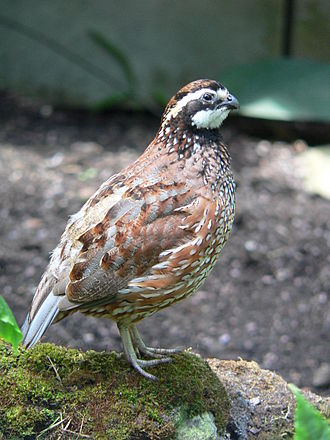Type the name of the breed you're looking for below
[wpdreams_ajaxsearchlite] Don't see the breed your're looking for? Click here and let us know!
Bobwhite Quail
| Origin | The Bobwhite, Virginia quail is a ground-dwelling bird native to the United States, Mexico, and the Caribbean. It is a member of the group of species known as New World quails. |
| Size | They can grow up to 9 in(23 cm) |
| Lifespan | They can live up to 13 years in captivity but in the wild only 3-6. |
| Noise | Usually not very loud unless housed with many birds in the same enclosure. |
| Characteristics | It has the typical chunky, rounded shape of a quail. The bill is short, curved and brown-black in colour. This species is sexually dimorphic. Males have a white throat and brow stripe bordered by black. The overall rufous plumage has gray mottling on the wings, white scalloped stripes on the flanks, and black scallops on the whitish underparts. The tail is gray. Females are similar but are duller overall and have a buff throat and brow without the black border. Both sexes have pale legs and feet. |
| Abilities | Some 28 different call types have been distinguished based on the circumstances in which they are used and the various behaviors that are exhibited during the call. The call types of the Japanese quail differ in between male and female, the same stimulus resulting in differing vocalizations. Most of the calls used by this quail are present after five weeks of development; however, they remain relatively changeable until sexual maturity is reached. |
| Interaction/Time Requirements, Diet, Supplies Needed | Quails live happily on the floor of the aviary. Aviaries are a large enclosure with a shelter from the elements and a flight area. An opening cut at low level, allowing the birds to move easily from the shelter into the flight area and back, ensures the birds can seek shelter from the elements when necessary. Quails like dry conditions, ensure the floor has proper drainage to avoid risk of flooding. Small gravel with and area of grass, along with some large plants for cover in the flight area should suffice. Quails should be given their food in the shelter for the extra protection offered. Special quail feeders ensure that they don't scatter their food across the floor. Small seeds, notably various millets, should form the basis of their diet. Augment their diet with live food occasionally, such as meal worms or crickets. |
| Other Considerations | This quail species is also an avid dust bather, individuals undergoing numerous bouts of dust bathing each day. When dust bathing, this bird will rake its bill and legs across the ground in order to loosen up the ground, and then use its wings to toss the dust into the air. As the dust falls back down to the ground around the bird, it will shake its body and ruffle its feathers to ensure they receive a thorough coating. |



